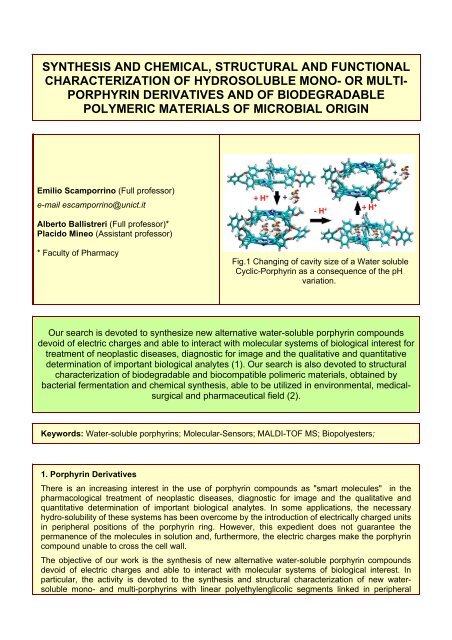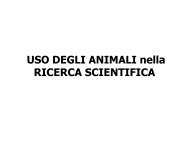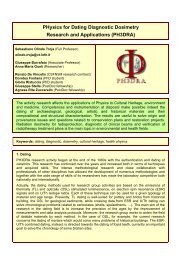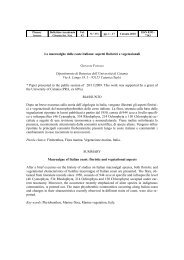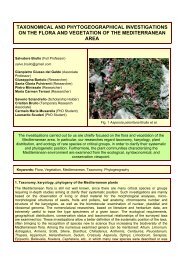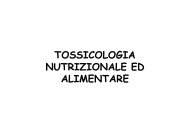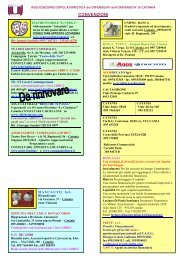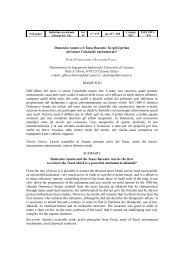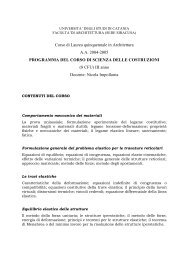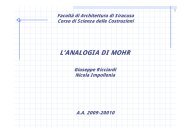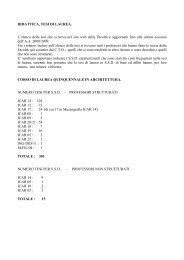show - università degli studi di catania
show - università degli studi di catania
show - università degli studi di catania
You also want an ePaper? Increase the reach of your titles
YUMPU automatically turns print PDFs into web optimized ePapers that Google loves.
SYNTHESIS AND CHEMICAL, STRUCTURAL AND FUNCTIONAL<br />
CHARACTERIZATION OF HYDROSOLUBLE MONO- OR MULTI-<br />
PORPHYRIN DERIVATIVES AND OF BIODEGRADABLE<br />
POLYMERIC MATERIALS OF MICROBIAL ORIGIN<br />
Emilio Scamporrino (Full professor)<br />
e-mail escamporrino@unict.it<br />
Alberto Ballistreri (Full professor)*<br />
Placido Mineo (Assistant professor)<br />
* Faculty of Pharmacy<br />
Fig.1 Changing of cavity size of a Water soluble<br />
Cyclic-Porphyrin as a consequence of the pH<br />
variation.<br />
Our search is devoted to synthesize new alternative water-soluble porphyrin compounds<br />
devoid of electric charges and able to interact with molecular systems of biological interest for<br />
treatment of neoplastic <strong>di</strong>seases, <strong>di</strong>agnostic for image and the qualitative and quantitative<br />
determination of important biological analytes (1). Our search is also devoted to structural<br />
characterization of biodegradable and biocompatible polimeric materials, obtained by<br />
bacterial fermentation and chemical synthesis, able to be utilized in environmental, me<strong>di</strong>calsurgical<br />
and pharmaceutical field (2).<br />
Keywords: Water-soluble porphyrins; Molecular-Sensors; MALDI-TOF MS; Biopolyesters;<br />
1. Porphyrin Derivatives<br />
There is an increasing interest in the use of porphyrin compounds as "smart molecules" in the<br />
pharmacological treatment of neoplastic <strong>di</strong>seases, <strong>di</strong>agnostic for image and the qualitative and<br />
quantitative determination of important biological analytes. In some applications, the necessary<br />
hydro-solubility of these systems has been overcome by the introduction of electrically charged units<br />
in peripheral positions of the porphyrin ring. However, this expe<strong>di</strong>ent does not guarantee the<br />
permanence of the molecules in solution and, furthermore, the electric charges make the porphyrin<br />
compound unable to cross the cell wall.<br />
The objective of our work is the synthesis of new alternative water-soluble porphyrin compounds<br />
devoid of electric charges and able to interact with molecular systems of biological interest. In<br />
particular, the activity is devoted to the synthesis and structural characterization of new watersoluble<br />
mono- and multi-porphyrins with linear polyethylenglicolic segments linked in peripheral
porphyrin ring structures. Some of our synthesized compounds, containing one or two porphyrin<br />
units, are resulted active in the molecular recognition of amino acids and study on more complex<br />
structures of biological interest (such as polypeptides and proteins) are in an advanced state of<br />
research. In particular, new multi-porphyrin derivatives, able to form complexes with bio-compounds<br />
and/or drugs and to allow their transport, with a three <strong>di</strong>mensional form (systems commonly called<br />
"molecular boxes") or with a planar extension ("molecular <strong>di</strong>sks" systems), have be synthesized.<br />
The goal of this research can be summarized in an attempt to prepare "smart" molecules able to<br />
fulfil new and specific functions of recognition and/or transport of biomolecules. The structural<br />
characterization of the synthesized samples is performed by means of chromatographic<br />
techniques, MALDI-TOF mass spectrometry, 1H-NMR, 13C-NMR, FT-IR, etc.. Molecular and<br />
functional properties of the more suitable molecules (and those of the correspon<strong>di</strong>ng host/guest<br />
systems) is also <strong>stu<strong>di</strong></strong>ed by means of spectropolarimetry (circular <strong>di</strong>chroism) and UV-visible<br />
spectroscopy.<br />
2. Biodegradable and biocompatible polyesters<br />
Poly(3-hydroxybutyrate-co-ε-caprolactone) copolymers have been obtained from the correspon<strong>di</strong>ng<br />
omopolymers (PHB and PCL) and poly(3-hydroxybutyrate-co-3-hydroxyvalerate-co-ε-caprolactone)<br />
terpolymers from the P(HB-co-HV) copolymer and PCL by using an acid catalized<br />
transesterification reaction. By a solvent deposition technique most samples gave micro- and nanoparticles<br />
potentially useful in the drug-delivery. Recently, some other biodegradable polyesters have<br />
been obtained by microbial fermentation from Brassica carinata oil and from very long chain fatty<br />
acids.<br />
Collaborations<br />
PRIN-2008 finanziamento: N. Prot. 2008KHW8K4<br />
CNR Istituto per la Chimica e Tecnologia dei Polimeri, Catania<br />
CNR- Istituto per i Processi Chimico-Fisici, Messina<br />
Dipartimento <strong>di</strong> Scienze Microbiologiche, Università <strong>di</strong> Messina<br />
Selected Publications<br />
1) DATTILO S., MINEO P., SCAMPORRINO E., SPINA E., VITALINI D. (2010). Synthesis and Characterization<br />
of New Copolyacrylates Containing Porphyrin Units as Pendant Groups and Their Use as Sensors. JOURNAL<br />
OF POLYMER SCIENCE. PART A, POLYMER CHEMISTRY, vol. 47; in press.<br />
2) SCAMPORRINO E., MINEO P., SCAMPORRINO A., DATTILO S., VITALINI D., ALICATA R. (2009).<br />
Polyethersulfone-Epoxy Terminated Materials as Thermosetting Resins for Microelectronic Devices. JOURNAL<br />
OF POLYMER SCIENCE. PART A, POLYMER CHEMISTRY, vol. 47; p. 5682-5689, ISSN: 0887-624X<br />
3) D. VITALINI, E. SPINA, S. DATTILO, P. MINEO, SCAMPORRINO E. (2008). Synthesis, Characterization and<br />
Nucleoti<strong>di</strong>c Chain Cleavage Ability of Uncharged Water- Soluble Poly(ethylene glycol)-Fullerene Derivatives with<br />
an Amphiphilic Character. JOURNAL OF POLYMER SCIENCE. PART A, POLYMER CHEMISTRY, vol. 46; p.<br />
2145-2153, ISSN: 0887-624X<br />
4) RICCO L, CASAZZA E, MINEO P, RUSSO S, SCAMPORRINO E. (2008). “Nature of a Low Molar Mass Peak<br />
in Anionic Poly(ε-caprolactam). Main Aspects of its Formation”. MACROMOLECULES, vol. 41; p. 3904-3911,<br />
ISSN: 0024-9297<br />
5) A. GULINO, I. FRAGAL, SCAMPORRINO E., D. VITALINI (2007). Similarities and Differences among<br />
Monolayers of a Free Base Porphyrin and Its Copper Complex: Synthesis and Characterization of a<br />
Luminescent Copper(II) Porphyrin Monolayer. JOURNAL OF PHYSICAL CHEMISTRY. C, NANOMATERIALS
AND INTERFACES, vol. 111; p. 14125-14130, ISSN: 1932-7447<br />
6) E. CASAZZA, L. RICCO, S. RUSSO, SCAMPORRINO E. (2007). Nature of a Low Molar Mass Peak in<br />
Anionic Poly(e-caprolactam). Its Identification as Macrocyclic Ensemble. MACROMOLECULES, vol. 40; p. 739-<br />
745, ISSN: 0024-9297<br />
7) F. BELLIA, D. LA MENDOLA, G. MACCARRONE, P. MINEO, D.VITALINI, SCAMPORRINO E., S. SORTINO,<br />
G. VECCHIO, E. RIZZARELLI (2007). Copper(II) Complex with b-cyclodextrin-homocarnosine Conjugates and<br />
their Antioxidant Activity. INORGANICA CHIMICA ACTA, vol. 360; p. 945-954, ISSN: 0020-1693<br />
8) SCAMPORRINO E., P. MINEO, S. DATTILO, D. VITALINI, E. SPINA (2007). Uncharged water-soluble metalbis-porphyrins<br />
like molecular tweezers for amino acids. MACROMOLECULAR RAPID COMMUNICATIONS, vol.<br />
28; p. 1546-1552, ISSN: 1022-1336<br />
9) V. VILLARI, P. MINEO, N. MICALI, N. ANGELINI, D. VITALINI, SCAMPORRINO E. (2007). Uncharged watersoluble<br />
metal-bis-porphyrins like molecular tweezers for amino acids. NANOTECHNOLOGY, vol. 18; p.<br />
375503/1-375503/13, ISSN: 0957-4484<br />
10) A. GULINO, P. MINEO, SCAMPORRINO E., D. VITALINI, I. FRAGALA (2006). Spectroscopic and<br />
Microscopic Characterization and Behavior of an Optical pH Meter Based on a Functional Hybrid Monolayer<br />
Molecular System: Porphyrin Molecules Covalently Assembled on a Molecularly Engineered Silica Surface.<br />
CHEMISTRY OF MATERIALS, vol. 18; p. 2404-2410, ISSN: 0897-4756<br />
11) A. GULINO, S. GIUFFRIDA, P. MINEO, M. PURRAZZO, SCAMPORRINO E., G. VENTIMIGLIA, M.E. VAN<br />
DER BOOM, I. FRAGALA (2006). Photoluminescence of a Covalent Assembled Porphyrin-Based Monolayer:<br />
Optical Behavior in the Presence of O2. JOURNAL OF PHYSICAL CHEMISTRY. B, CONDENSED MATTER,<br />
MATERIALS, SURFACES, INTERFACES & BIOPHYSICAL, vol. 110; p. 16781-16786, ISSN: 1520-6106<br />
12) SCAMPORRINO E., P. MINEO, D. VITALINI, E. SPINA, R. RAPISARDI (2006). Synthesis and MALDI-TOF<br />
Characterization of Bisphenol-A Copolyformals Containing Nickel(II)/Schiff-Base, Eicosane and 2-Butene Units<br />
in the Main-Chain. RAPID COMMUNICATIONS IN MASS SPECTROMETRY, vol. 20; p. 2961-2968, ISSN:<br />
0951-4198<br />
13) R. ALICATA, T. BARBUZZI, M. GIUFFRIDA AND A. BALLISTRERI (2006). Characterization of Poly(3hydroxybutyrate-co-ε-caprolactone)<br />
Copolymers by Matrix-Assisted Laser Desorption/Ionization Time-of-Flight<br />
and Electrospray Ionization Mass Spectrometry”. RAPID COMMUN. MASS SPECTROM., vol. 20, p. 568 ISSN:<br />
0951-4198.<br />
14) G. IMPALLOMENI , A. STEINBUCHEL, T. LUTKE-EVERSLOH , T. BARBUZZI, A. BALLISTRERI (2007).<br />
Sequencing Microbial Copolymers of 3-hydroxybutyric and 3-mercaptoalkanoic Acids by NMR, Electrospray<br />
Ionization Mass Spectrometry, and Size Exclusion Chromatography NMR”.<br />
BIOMACROMOLECULES, vol. 8, p. 985-991.<br />
15) R. PIGNATELLO, T. MUSUMECI, G. IMPALLOMENI, G. M. CARNEMOLLA, G. PUGLISI, A. BALLISTRERI<br />
(2009). Poly(3-hydroxybutyrate-co-ε-caprolactone) Copolymers and Poly(3-hydroxybutyrate-co-3hydroxyvalerate-co-ε-caprolactone)<br />
Terpolymers as Novel Materials for Colloidal Drug Delivery Systems”. EUR.<br />
J. PHARM. SCI., vol. 37, p. 451-462.<br />
16) R. PIGNATELLO, V. PANTO`, L. BASILE, G. IMPALLOMENI, A. BALLISTRERI, V. PISTARA`, F.<br />
CRAPARO, G. PUGLISI (2010). New Amphiphilic Conjugates of Mono- and Bis(carboxy)-PEG 2,000 Polymers<br />
with LipoaminoAcids as Surface Mo<strong>di</strong>fiers of Colloidal Drug Carriers”. MACROMOL. CHEM. PHYS., vol. 211,<br />
p.1148–1156.<br />
17) IMPALLOMENI, A. BALLISTRERI, G. M. CARNEMOLLA, S. P. P. GUGLIELMINO, M. S. NICOLÒ, M. G.<br />
CAMBRIA (2011). Synthesis and Characterization of Poly(3-hydroxyalkanoates) from Brassica Carinata Oil with<br />
High Content of Erucic Acid and from Very Long Chain Fatty Acids”. INT. J. BIOL. MACROMOL., vol. 48, 137-<br />
145.
Patents:<br />
18) SCAMPORRINO E., VITALINI D, MINEO P, ALICATA R (2008). “Copolieteresolfoni-epossidati<br />
termoindurenti auto-catalizzati: preparazione ed uso come colle isolanti ad alta prestazione per assemblaggi in<br />
microelettronica”. N° CT2008A000003. Università <strong>di</strong> Catania<br />
19) A. BALLISTRERI, G. IMPALLOMENI, G. C. CARNEMOLLA, S. P. P. GUGLIELMINO, M. S. NICOLÒ, M.<br />
G. CAMBRIA (2009). Production of biodegradable plastics from Brassica carinata oil ad with high content of<br />
erucic acid and from very long chain fatty acids”. Brevetto Internazionale PCT/IT2009/000458 depositato il<br />
12/10/2009.<br />
20) R. PIGNATELLO, V. PANTÒ, G. PUGLISI, A. BALLISTRERI, G. IMPALLOMENI (2008). Derivati anfifilici<br />
del poliossietilenglicole (PEG), proce<strong>di</strong>menti <strong>di</strong> preparazione e loro usi nella preparazione <strong>di</strong> sistemi<br />
farmaceutici”.<br />
Depositato il 15/10/2008 presso la Camera <strong>di</strong> Commercio Industria Artigianato e Agricoltura <strong>di</strong> Roma, n. RM<br />
2008 A 551.


